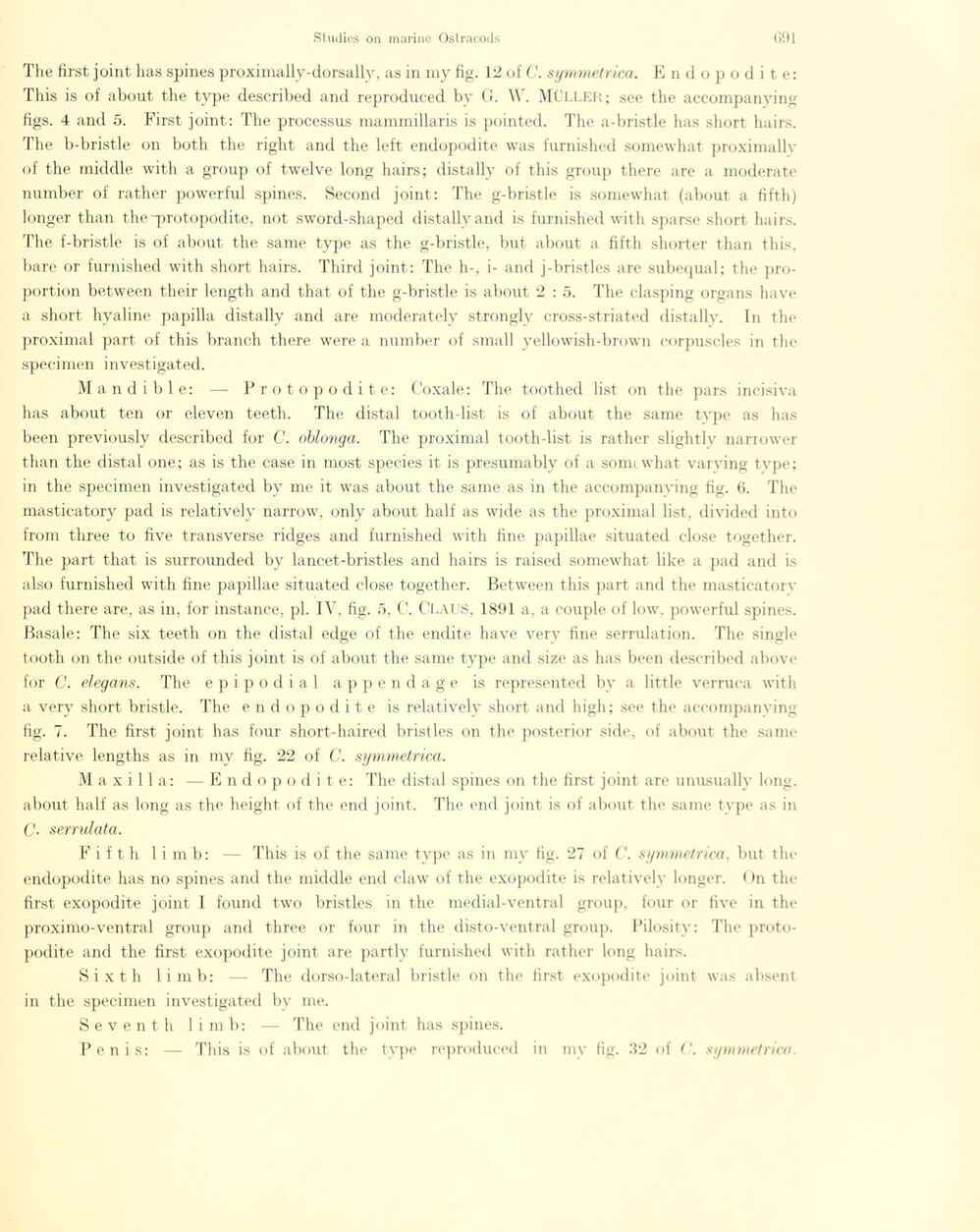
Full resolution (JPEG) - On this page / på denna sida - Sidor ...

<< prev. page << föreg. sida << >> nästa sida >> next page >>
Below is the raw OCR text
from the above scanned image.
Do you see an error? Proofread the page now!
Här nedan syns maskintolkade texten från faksimilbilden ovan.
Ser du något fel? Korrekturläs sidan nu!
This page has never been proofread. / Denna sida har aldrig korrekturlästs.
The first joint has spines proximally-dorsally, as in my fig. 12 of C. symmetrica. Endopodite:
This is of about the type described and reproduced by G. W. MÜLLER; see the accompanying
figs. 4 and 5. First joint: The processus mammillaris is pointed. The a-bristle has short hairs.
The b-bristle on botli the right and the left endopodite was furnished somewhat proximallv
of the middle with a group of twelve long hairs; distally of this group there are a moderate
number of rather powerful spines. Second joint: The g-bristle is somewhat (about a fifth)
longer than the-protopodite, not sword-shaped distally and is furnished with sparse short hairs.
The f-bristle is of about the same type as the g-bristle, but about a fifth shorter than this.
bare or furnished with short hairs. Third joint: The h-, i- and j-bristles are subequal; the
proportion between their length and that of the g-bristle is about 2 : o. The clasping organs have
a short hyaline papilla distally and are moderately strongly cross-striated distally. In the
proximal part of this brauch there were a number of small yellowish-brown corpuscles in the
specimen investigated.
Mandible: — Protopodite: Coxale: The toothed list on the pars incisiva
has about ten or eleven teeth. The distal tooth-list is of about the same type as has
been previously described for C. oblonga. The proximal tooth-list is rather slightly narrower
than the distal one; as is the case in most species it is presumably of a somewhat varving tvpe;
in the specimen investigated by me it was about the same as in the accompanying fig. 6. The
masticatory pad is relatively narrow, only about half as wide as the proximal list. divided into
from three to five transverse ridges and furnished with fine papillae situated close together.
The part that is surrounded by lancet-bristles and hairs is raised somewhat lilce a pad and is
also furnished with fine papillae situated close together. Between this part and the masticatorv
pad there are, as in, for instance, pi. IV, fig. 5, C. Claus, 1891 a, a couple of low. powerful spines.
Basale: The six teeth on the distal edge of the endite have very fine serrulation. The single
tooth on the outside of this joint is of about the same type and size as has been described above
for C. elegans. The epipodial a p p e n d a g e is represented by a little verruca with
a very short bristle. The endopodite is relatively short and high; see the accompanying
fig. 7. The fii’st joint lias four short-haired bristles on the posterior side, of about the same
relative lengths as in my fig. 22 of C. symmetrica.
Maxilla: — Endopodite: The distal spines on the first joint are unusually long,
about half as long as the height of the end joint. The end joint is of about the same type as in
C• serrulata.
Fifth 1 i m b: — This is of the same type as in my fig. 27 of C. symmetrica, but the
endopodite has no spines and the middle end claw of the exopodite is relatively longer. On the
first exopodite joint 1 found two bristles in the medial-ventral group, four or five in the
proximo-ventral group and three or four in the disto-ventral group. Pilosity: The
protopodite and the first exopodite joint are partly furnished with rather long hairs.
Sixth limb: — The dorso-lateral bristle on the first exopodite joint was absent
in the specimen investigated by me.
S e v e n t h limb: — The end joint has spines.
Penis: — This is of about the tvpe reproduced in mv fig. 32 of C. symmetrica.
<< prev. page << föreg. sida << >> nästa sida >> next page >>